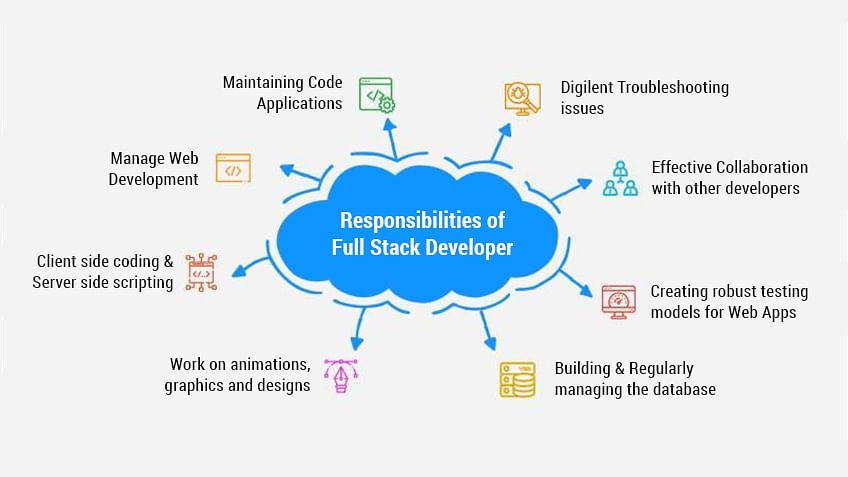November 18, 2024
 by Bridget Poetker / November 18, 2024
by Bridget Poetker / November 18, 2024

As technology advances, most developers tend to specialize and stick to a specific area. Front-end and back-end development each have unique challenges, often requiring programmers to focus on one or the other.
However, full-stack developers defy this trend. They bridge the gap between front-end and back-end development, possessing a broad range of skills that allow them to work across the entire stack.
Full-stack developers design and build websites and applications across multiple platforms. Their role combines the responsibilities of both front-end and back-end developers,
To streamline this process, they often use DevOps platforms which enable efficient development, deployment, and maintenance of applications.
Imagine how a clock works: the front-end is like the clock face, where users see the hands and numbers to tell time. The back-end, on the other hand, is the intricate system of cogs and gears inside that powers the clock and keeps it running smoothly. Full-stack developers manage both aspects, ensuring everything works seamlessly together.
While full-stack developers aren’t necessarily masters at either process, they have enough general knowledge and skill to work on both adequately and jump in when needed.
If you aspire to become a full-stack developer, embracing a well-rounded skill set is essential, as it will empower you to tackle diverse projects and adapt to the ever-evolving tech landscape. Following a full-stack developer roadmap can make this journey more efficient. Learn more in this article.
On the front end, they design and implement user interfaces using technologies like HTML, CSS, and JavaScript, ensuring a seamless and engaging user experience.
On the back end, they develop server-side logic, manage databases, and create APIs using programming languages such as Node.js, Python, or Ruby.

Source: simplilearn
Full-stack developers also collaborate with other team members, troubleshoot issues, and optimize application performance, making them integral to the entire development process.
Their ability to navigate both layers of development allows them to create cohesive and efficient applications that meet user needs.
In order to become a full stack developer, you must have a functional knowledge of each and every aspect of building an app, website, or any other digital projects for that matter. Full stack developers should be proficient in a range of areas and thus possess a wide variety of skills.
You are most likely fluent with at least one programming language. Start with what you know and build from there. There are a few front-end languages that have similar syntax, so after you learn the basic foundation and advanced concepts of one, the learning curve isn’t as steep for the second.
Also, make sure to cover your bases and learn languages specific to web AND app development – even platform-specific languages like Apple’s Swift. A full stack developer typically has intermediate knowledge of these front-end languages:
Once you feel comfortable with the front-end languages, it’s time to learn a back-end language – or two. These are generally more intensive programming languages because you’re dealing with databases and logic. A few common back-end languages include:
I know you’re not a designer. But, it’s extremely advantageous for a full stack developer to learn the basics and best practices of web and app design. It all starts with the code, so understanding how a designer thinks and works before you start programming makes overall team communication easy and efficient.
Any digital project needs a database to store data that will later be accessed by the app or website. Every project has different needs, so a full-stack developer must be familiar with several different types of databases.
In fact, database skills are highly important to employers worldwide. According to the Devskiller Global Technical Hiring and Skills Report 2025, most developers will get a database skills assessment as a part of the recruitment process, regardless of their expertise area.
Relational databases like Microsoft SQL and MySQL are often used for large-scale products. Learning the ins and outs of multiple databases for various use cases is highly recommended.
SQL appears in 4 out of 8 pairs of technologies most commonly tested together. The most popular SQL duplets include:
This proves that database skills are tested not only when hiring for full-stack roles, but also for front end and back end roles. If you recruit for developer positions, here's a comprehensive guide on screening SQL skills to help you out.
Utilizing existing or developing new application programming interfaces (API) is another skill full stack programmers should develop. Putting these “puzzle pieces” together speeds up the development process and can be incredibly helpful when used properly. This specific skill can save you time and money in the long run. For instance, learning how to implement AJAX PHP techniques can enhance asynchronous communication between the front-end and server, reducing page reloads and improving performance
Becoming a full-stack developer comes with numerous benefits that can accelerate your career in web application development:
Becoming a full-stack developer requires a mix of technical knowledge, practical experience, and an understanding of various programming languages and frameworks. Here’s a guide to help you get started and advance as a full-stack developer.
Start by selecting a learning path that suits your preferences and lifestyle. Online courses from platforms like Coursera, edX, and Udacity offer structured learning from recognized institutions, allowing you to study at your own pace.
Tip: Enroll in the IBM full stack software developer professional certificate course offered by Cursera today! This comprehensive program will equip you with the essential skills and knowledge needed to excel in full-stack development.
Bootcamps provide immersive, hands-on experiences in a condensed time frame, which can be ideal for quickly transitioning into the field.
Many community colleges also offer degree programs or certifications in web development. Additionally, a computer science degree can provide a strong theoretical foundation for your career.
Enhance your learning with recommended books like “Eloquent JavaScript” by Marijn Haverbeke, which covers essential programming concepts, or “You Don’t Know JS” by Kyle Simpson for a deeper dive into JavaScript.
Finally, practice your skills through personal projects, contribute to open-source initiatives, and build a portfolio to showcase your work.
To become a full-stack developer, it's essential to build a strong portfolio that showcases your skills and projects.
Aspiring developers can work on mini projects under the supervision of a college professor and focusing on real-world problems that require technical solutions. For instance, creating a local event management app or a simple inventory management system for a small business can provide valuable hands-on experience. Documenting the process and challenges faced during these projects will enhance your portfolio, making it more engaging and informative for potential employers.
Additionally, contributing to open-source projects on platforms like GitHub allows you to collaborate with experienced developers and gain insights into industry standards. You can also create applications that tackle contemporary issues, such as a health tracking app or a web platform that connects students with tutors.
By showcasing these projects on a personal website and sharing them on social media, you can effectively demonstrate your full-stack development skills and attract job opportunities in the field.
Practice coding challenges to sharpen your problem-solving skills. Use platforms like LeetCode, HackerRank, or CodeSignal to work through algorithms and data structures, focusing on both frontend and backend scenarios.
Additionally, consider mock interviews to simulate the interview environment and receive feedback on your performance, helping you build confidence for the actual interview.
According to Glassdoor, the average self-reported full-stack developer salary is around $90,840 per year. Of course, the salaries vary greatly – starting at $55,000 and going up to $120,000+ for more senior developer positions. It’s also common to see project-based contract work, usually paid hourly.
While it's common for full-stack roles to demand more experience than other developer positions, such as front-end or back-end developers, this shouldn't discourage you from applying for entry-level jobs.
Many companies are open to candidates with a strong foundational understanding of programming languages, frameworks, and development practices, even without extensive professional experience.
To build your qualifications, start small by working on personal projects or contributing to open-source initiatives. Additionally, consider internships or freelance opportunities that allow you to gain hands-on experience while learning the intricacies of full-stack development.
Networking is another essential aspect of breaking into the field. Attend local tech events, join online communities, and connect with other developers to build relationships that may lead to job opportunities. When applying for positions, tailor your resume and cover letter to highlight your relevant skills and projects, emphasizing your enthusiasm for learning and growth.
Remember, every expert starts as a beginner, so stay persistent, keep improving your skills, and don’t be discouraged by rejections; your determination will eventually lead you to the right opportunity.
There are over 15,000 full stack developers jobs listed on Indeed right now. This role is in high demand. While some companies still prefer to hire highly specialized developers, there is a general shift toward a more well-rounded, problem-solving type of developer. It’s important to remember that full stack developer jobs typically require more work experience than other developer roles.
Within any role, there is room for strengths and weaknesses. The same goes for full-stack development. Chances are you’re coming in with a development background, and your strength will lie on either the front-end or back-end. Play to your strengths, but build up your shortcomings with research and practical experience.
Explore G2's app development hub and take the first step toward mastering full-stack development.
This article was originally published in 2019. It has been updated with new information.
Bridget Poetker is a former content team lead at G2. Born and raised in Chicagoland, she graduated from U of I. In her free time, you'll find Bridget in the bleachers at Wrigley Field or posted up at the nearest rooftop patio. (she/her/hers)
When it comes to the tech industry, you can’t deny how important a well-rounded web developer...
 by Mara Calvello
by Mara Calvello
Every idea for a website starts somewhere.
 by Mara Calvello
by Mara Calvello
If you’re familiar with the world of software development, you might have come across the...
 by Reinder de Vries
by Reinder de Vries
When it comes to the tech industry, you can’t deny how important a well-rounded web developer...
 by Mara Calvello
by Mara Calvello
Every idea for a website starts somewhere.
 by Mara Calvello
by Mara Calvello


